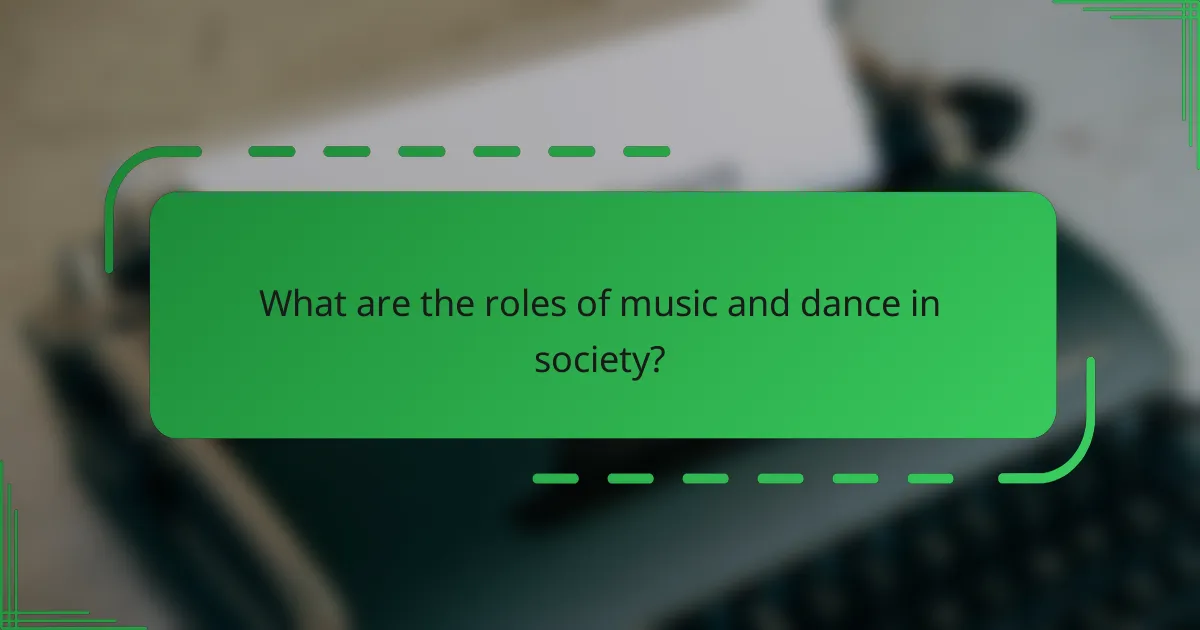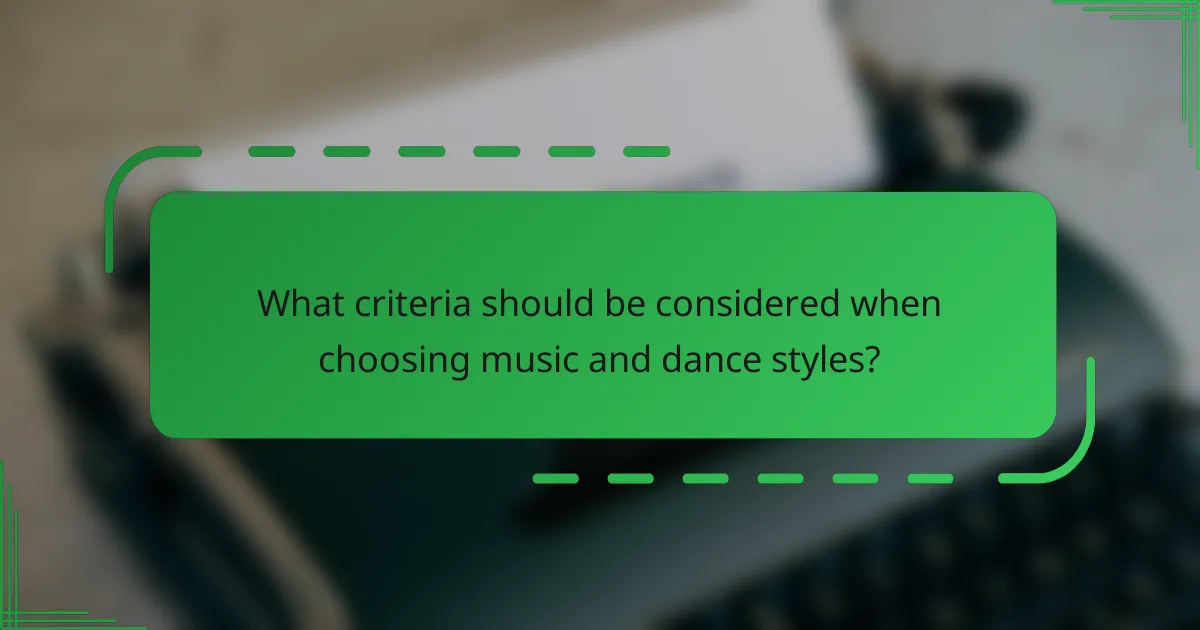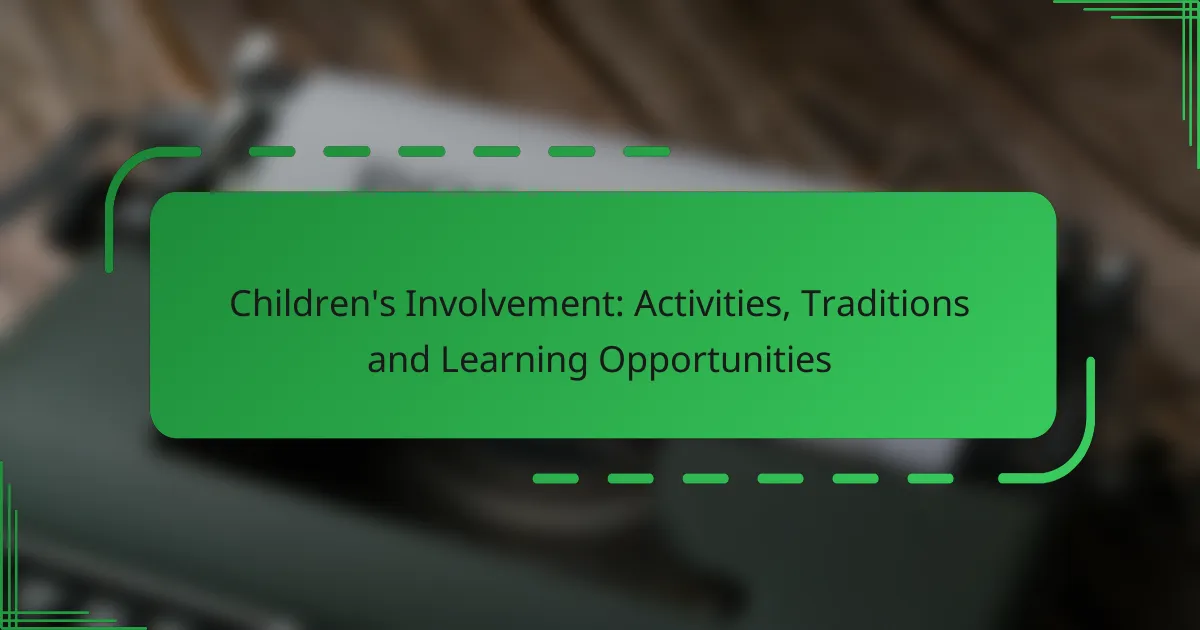Music and dance are essential components of cultural expression, playing a crucial role in communication and the reinforcement of social bonds. They not only accompany celebrations and rituals but also embody the unique traditions and values of diverse communities. Various styles, from classical to hip-hop, showcase the rich tapestry of human creativity and cultural significance.

What are the roles of music and dance in society?
Music and dance serve vital roles in society by facilitating communication, expressing cultural identity, and enhancing social bonds. They are integral to celebrations, rituals, and community gatherings, reflecting the values and traditions of different cultures.
Expression of cultural identity
Music and dance are powerful mediums for expressing cultural identity, allowing individuals and communities to showcase their heritage. Traditional songs and dances often encapsulate historical narratives, beliefs, and values, fostering a sense of belonging among participants.
For example, folk dances in Eastern Europe often reflect local customs and stories, while Indigenous music in North America conveys spiritual connections to the land. These forms of expression help preserve cultural legacies for future generations.
Community bonding and social cohesion
Participating in music and dance activities fosters community bonding and strengthens social cohesion. Group performances, such as community dances or choir singing, create shared experiences that enhance relationships among participants.
Events like festivals or cultural celebrations often involve collective music and dance, drawing people together and promoting unity. This shared participation can break down social barriers and encourage inclusivity within diverse communities.
Emotional and psychological benefits
Engaging in music and dance offers significant emotional and psychological benefits. These activities can serve as outlets for self-expression, helping individuals process emotions and cope with stress. Research suggests that rhythmic movement and music can elevate mood and reduce anxiety.
Moreover, participating in group dance or music sessions can foster feelings of happiness and belonging, contributing to overall mental well-being. Regular involvement in these activities can lead to improved self-esteem and social skills.
Educational and developmental functions
Music and dance play crucial educational and developmental roles, particularly for children. They enhance cognitive skills, such as memory and attention, while also promoting physical coordination and motor skills through movement.
In educational settings, incorporating music and dance into curricula can make learning more engaging and effective. Programs that include these elements often see improved academic performance and social interactions among students.

What are the major styles of music and dance?
The major styles of music and dance encompass a wide range of genres, each with unique characteristics and cultural significance. These styles include classical music paired with ballet, jazz alongside contemporary dance, hip-hop in conjunction with street dance, and folk music featuring traditional dance forms.
Classical music and ballet
Classical music and ballet are often intertwined, with ballet relying on the emotive power of orchestral compositions. This style emphasizes precision, technique, and storytelling through movement, typically performed in theaters. Ballet performances often feature elaborate costumes and sets, enhancing the visual experience.
Key elements of classical ballet include positions of the feet, graceful arm movements, and a structured approach to choreography. Notable ballet styles include Russian, French, and Italian, each offering distinct techniques and aesthetics.
Jazz and contemporary dance
Jazz music and contemporary dance share a dynamic relationship, characterized by improvisation and expressive movement. Contemporary dance often incorporates elements from various styles, including jazz, allowing for a fluid and innovative performance style. This genre encourages individual interpretation and creativity.
Jazz dance typically features energetic movements, syncopated rhythms, and a strong connection to the music. Dancers often use their bodies to convey emotion, making this style particularly engaging for audiences.
Hip-hop and street dance
Hip-hop music and street dance emerged from urban culture, emphasizing self-expression and community. Street dance encompasses various styles, including breaking, locking, and popping, often performed in informal settings like streets or parks. This genre is known for its improvisational nature and focus on rhythm.
Key characteristics of hip-hop dance include sharp movements, intricate footwork, and a strong connection to the beat. Dancers often participate in battles, showcasing their skills and creativity in a competitive environment.
Folk music and traditional dance
Folk music and traditional dance reflect the cultural heritage of specific communities, often passed down through generations. These styles are typically characterized by their use of local instruments and rhythms, creating a sense of identity and belonging. Traditional dances often accompany folk music during celebrations and festivals.
Common folk dance forms include the Irish jig, Scottish reel, and various regional dances found worldwide. Participants often engage in group formations, promoting social interaction and community bonding.

How do music and dance influence cultural practices?
Music and dance are integral to cultural practices, serving as expressions of identity, tradition, and community values. They shape social interactions and reinforce cultural norms through shared experiences and collective participation.
Rituals and ceremonies
Rituals and ceremonies often incorporate music and dance to mark significant life events, such as births, weddings, and funerals. These performances can enhance the emotional impact of the occasion, creating a deeper connection among participants.
For instance, in many Indigenous cultures, traditional songs and dances are performed during rites of passage, reinforcing cultural heritage and community bonds. The specific styles and instruments used can vary widely, reflecting local traditions and beliefs.
Festivals and celebrations
Festivals and celebrations frequently feature music and dance as central components, bringing communities together in joyous expression. These events can showcase local talent and cultural diversity, often attracting visitors and tourists.
Examples include the Carnival in Brazil, where samba music and dance are vital, and Oktoberfest in Germany, which features traditional folk music and dances. Such festivals not only celebrate cultural identity but also stimulate local economies through tourism.
Political and social movements
Music and dance play crucial roles in political and social movements, serving as tools for protest and solidarity. They can convey messages, inspire action, and unite individuals around a common cause.
For example, protest songs during the Civil Rights Movement in the United States galvanized support and spread awareness. Similarly, dance styles like hip-hop have become symbols of resistance and empowerment in various social movements worldwide.

What are the benefits of participating in music and dance?
Participating in music and dance offers numerous benefits, including improved physical health, enhanced social skills, and opportunities for creativity and self-expression. Engaging in these activities can lead to a more fulfilling and connected life.
Physical health and fitness
Music and dance promote physical health by encouraging movement and exercise. Regular participation can improve cardiovascular fitness, flexibility, and strength, contributing to overall well-being. For instance, dance styles like ballet or hip-hop can burn significant calories, often ranging from 300 to 600 calories per hour, depending on intensity.
Additionally, music can enhance physical coordination and balance. Activities such as drumming or playing instruments require fine motor skills, which can help improve hand-eye coordination. Incorporating music and dance into your routine can be a fun way to stay active and healthy.
Social skills and teamwork
Engaging in music and dance fosters social skills and teamwork, as these activities often involve collaboration with others. Whether in a dance class or a band, participants learn to communicate effectively, share ideas, and work towards common goals. This collaborative environment helps build trust and camaraderie among peers.
Moreover, performing in front of an audience can boost confidence and reduce social anxiety. Regular interaction in group settings encourages individuals to develop strong interpersonal skills, which are valuable in both personal and professional contexts.
Creativity and self-expression
Music and dance provide powerful outlets for creativity and self-expression. These activities allow individuals to explore their emotions and convey their thoughts through movement and sound. For example, improvisational dance encourages spontaneity and personal interpretation, fostering a unique artistic voice.
Additionally, creating music or choreography can enhance problem-solving skills and critical thinking. Engaging in these creative processes often leads to a deeper understanding of oneself and can serve as a therapeutic tool for managing stress and emotional challenges.

What criteria should be considered when choosing music and dance styles?
When selecting music and dance styles, consider factors such as audience preferences, the context of the event, and the need for accessibility. These criteria help ensure that the chosen styles resonate with participants and enhance the overall experience.
Audience preferences and demographics
Understanding the audience’s preferences and demographics is crucial when choosing music and dance styles. Factors like age, cultural background, and musical tastes can significantly influence what styles will be well-received. For example, younger audiences may prefer contemporary genres, while older generations might enjoy classic or traditional forms.
Gathering feedback through surveys or informal discussions can provide insights into what styles resonate most with your audience. Tailoring your choices to match these preferences can enhance engagement and enjoyment.
Event type and cultural context
The type of event and its cultural context play a significant role in determining appropriate music and dance styles. For instance, a wedding may call for romantic and celebratory music, while a corporate event might require more subdued and professional selections. Additionally, cultural traditions can dictate specific styles that are expected or appreciated.
Consider the theme and purpose of the event when making your selections. Aligning music and dance styles with the event’s context can create a more cohesive and memorable experience for attendees.
Accessibility and inclusivity
Accessibility and inclusivity are essential considerations when choosing music and dance styles. Ensure that the selected styles are welcoming to all participants, regardless of their physical abilities or cultural backgrounds. This might involve incorporating a variety of genres or adapting dance styles to accommodate different skill levels.
Offering options such as sign language interpretation for music or providing space for different dance styles can enhance inclusivity. Aim to create an environment where everyone feels comfortable participating, which can lead to a richer experience for all involved.

What are the emerging trends in music and dance?
Emerging trends in music and dance reflect a blend of technology, cultural fusion, and evolving audience preferences. Artists are increasingly incorporating digital tools and global influences, leading to innovative styles and performances.
Technology’s Impact on Music and Dance
Technology plays a crucial role in shaping contemporary music and dance. Digital platforms allow artists to share their work globally, while software for music production and dance choreography enhances creativity. Streaming services have shifted how audiences consume music, favoring playlists and short-form content.
Moreover, virtual reality (VR) and augmented reality (AR) are becoming popular in performances, offering immersive experiences. For instance, VR concerts allow fans to attend shows from their homes, broadening access and engagement.
Cultural Fusion in Performance
Cultural fusion is increasingly evident in music and dance, as artists blend diverse styles to create unique expressions. This trend reflects globalization, where influences from various cultures merge, leading to new genres and dance forms. Examples include K-pop’s integration of hip-hop and traditional Korean elements.
Collaborations across genres are common, with artists from different backgrounds working together to produce innovative pieces. This not only enriches the art forms but also promotes cross-cultural understanding and appreciation.
Audience Engagement and Participation
Modern audiences seek more interactive and participatory experiences in music and dance. Social media platforms enable fans to engage directly with artists, influencing trends and promoting viral challenges. This shift encourages artists to create content that resonates with their audience’s preferences.
Live performances are also evolving, with many incorporating audience participation elements. For example, dance workshops before concerts allow fans to learn choreography, enhancing their connection to the performance.



